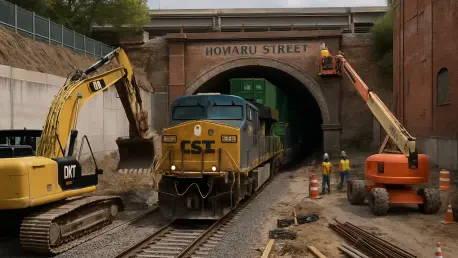In the heart of Baltimore, Maryland, a historic railway tunnel, once a stubborn bottleneck for modern freight, has undergone a transformation so swift it’s left industry experts stunned, marking a significant milestone in infrastructure development. The Howard Street Tunnel, a vital artery for CSX Transportation, was modernized in a $450 million project that wrapped up nearly two years ahead of its August 2027 deadline. How did a complex infrastructure overhaul beneath a bustling city defy expectations with such speed? This remarkable achievement isn’t just about construction—it’s a story of innovation and grit that’s reshaping the future of rail transport across the Mid-Atlantic to the Midwest.
A Critical Link Reborn
The significance of this project lies in its impact on national freight logistics. Built in 1895, the Howard Street Tunnel connects Baltimore to key Midwest markets, but its outdated clearance couldn’t accommodate double-stack trains, slowing down cargo movement and clogging supply chains. Modernizing this 8,700-foot passage was essential to boost efficiency, cut road congestion, and support economic growth. The early completion marks a pivotal win for businesses and policymakers banking on faster, smoother transport routes.
Beyond mere logistics, this tunnel’s upgrade reflects a broader push to revitalize aging infrastructure. With rail capacity now enhanced, the project aligns with CSX’s capital improvement goals stretching from Baltimore to Philadelphia. It’s a signal that even the oldest structures can be adapted for today’s demands, proving that strategic investments yield outsized returns for regional connectivity.
Unpacking the Secrets of Speed
What drove this project to finish so far ahead of schedule? A major factor was the adoption of a progressive design-build approach by the joint venture of Skanska and Fay, a Mid-Atlantic infrastructure firm. This method merged design and construction phases, allowing for real-time tweaks and cost efficiencies that traditional models often lack. Flexibility became the backbone of progress, ensuring challenges were met with immediate solutions.
Another bold move was securing CSX’s approval for a full tunnel closure, paired with a grueling 24/7 work schedule spanning over seven months. This intensive approach slashed downtime and kept momentum high, all while maintaining strict safety standards. It was a calculated risk that paid off, showing how strategic planning can compress timelines without cutting corners.
Technically, the task was daunting—raising the tunnel’s clearance by 2 feet to handle modern trains required demolishing the original floor and installing nearly 1,200 precast concrete slabs. A custom railcar-mounted gantry crane was engineered for the job, preserving the historic archway dating back over a century. This blend of innovation and respect for heritage turned a logistical puzzle into a showcase of engineering prowess.
Teamwork at the Core
Collaboration proved to be the heartbeat of this endeavor. Michael Goetz, Skanska’s project manager, highlighted the strength of unity, noting, “The progressive design-build method let us align priorities through genuine partnership with CSX and our design team.” His words underscore how shared goals can break through the toughest barriers in infrastructure work.
Daily coordination became a lifeline during the relentless round-the-clock shifts. Open communication channels ensured that setbacks were tackled swiftly, keeping the project on track even under intense pressure. Industry observers agree that this level of synergy isn’t just a bonus—it’s a necessity for redefining what’s possible in tight timelines.
The ripple effect of such teamwork extends beyond this single tunnel. It sets a standard for how stakeholders can unite around complex challenges, offering a glimpse into the power of collective effort. For those on the ground, every decision, every late-night shift, built not just a tunnel but a legacy of partnership.
Redefining Infrastructure Timelines
This project’s success offers a roadmap for other initiatives aiming to beat the clock. Embracing progressive design-build models stands out as a key lesson, integrating planning and execution to solve problems faster and control costs. It’s a shift from rigid frameworks to dynamic, adaptive strategies that prioritize results.
Negotiating strategic closures, as CSX did with the tunnel outage, also emerges as a game-changer. By condensing work into focused, uninterrupted periods, productivity soared, proving that temporary sacrifices can yield long-term gains. This tactic requires stakeholder buy-in but delivers undeniable efficiency when executed well.
Finally, investing in tailored solutions, like the specialized gantry crane, shows the value of customizing tools to unique challenges. Such innovation ensures quality isn’t sacrificed for speed, balancing modern needs with historical preservation. These principles, rooted in real outcomes from Baltimore, chart a course for future projects to enhance capacity and cut delays.
Reflections and Future Pathways
Looking back, the Howard Street Tunnel modernization stood as a testament to what bold strategies and unified efforts could achieve. The joint venture’s ability to adapt, innovate, and push through round-the-clock challenges redefined expectations for infrastructure upgrades. It wasn’t just about clearing a path for double-stack trains—it was about proving that even the most entrenched obstacles could be overcome with the right approach.
Moving forward, the industry must build on these lessons, applying progressive methods and custom solutions to other aging corridors. Policymakers and companies should prioritize collaboration, ensuring that stakeholders align on shared visions for efficiency. The success in Baltimore could inspire a wave of projects that transform logistics across the nation.
As new challenges arise in rail and beyond, the focus should shift to scalable models that replicate this efficiency. Investing in technology and teamwork will be critical to tackling the next bottlenecks. The story of this tunnel serves as a reminder that with ingenuity, timelines are not just met—they’re shattered, paving the way for a more connected tomorrow.









